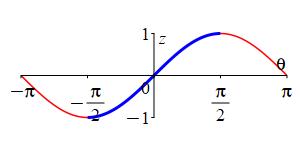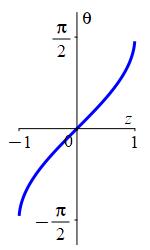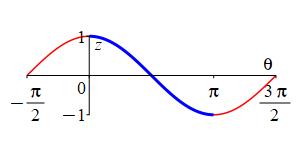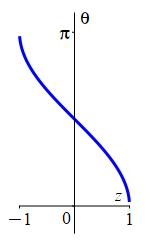3. Trigonometry
e. Inverse Trig Functions
2. Inverse Sine & Cosine
Arc Sine
The sine function is not one-to-one, since for example \[ \sin(\pi-\theta)=\sin(\theta) \] We pick the branch with \(-\,\dfrac{\pi}{2} \le \theta \le \dfrac{\pi}{2}\).

The inverse function of \(\sin\) is \(\arcsin\) (read “arc sine”) or \(\sin^{-1}\) (read “inverse sine”) which satisfies \[ \arcsin(z)=\theta \qquad \text{where} \qquad z=\sin(\theta) \] provided \(-1 \le z \le 1\) and \(-\,\dfrac{\pi}{2} \le \theta \le \dfrac{\pi}{2}\).
Notice that \(-\,\dfrac{\pi}{2} \le \theta \le \dfrac{\pi}{2}\) is quadrants IV and I only.

Compute each of the following.
-
\(\arcsin\dfrac{1}{2}\)
\(\arcsin\dfrac{1}{2}=\dfrac{\pi}{6}\)
-
\(\arcsin\dfrac{-1}{\sqrt{2}}\)
\(\arcsin\dfrac{-1}{\sqrt{2}}=-\,\dfrac{\pi}{4}\)
-
\(\arcsin\dfrac{\sqrt{3}}{2}\)
\(\arcsin\dfrac{\sqrt{3}}{2}=\dfrac{\pi}{3}\)
-
\(\arcsin(-1)\)
\(\arcsin(-1)=-\,\dfrac{\pi}{2}\)
Arc Cosine
The cosine function is not one-to-one, since for example \[ \cos(-\theta)=\cos(\theta) \] We pick the branch with \(0 \le \theta \le \pi\).

The inverse function of \(\cos\) is \(\arccos\) (read “arc cosine”) or \(\cos^{-1}\) (read “inverse cosine”) which satisfies \[ \arccos(z)=\theta \qquad \text{where} \qquad z=\cos(\theta) \] provided \(-1 \le z \le 1\) and \(0 \le \theta \le \pi\).
Notice that \(0 \le \theta \le \pi\) is quadrants I and II only.

Compute each of the following.
-
\(\arccos\dfrac{1}{2}\)
\(\arccos\dfrac{1}{2}=\dfrac{\pi}{3}\)
-
\(\arccos\dfrac{-1}{\sqrt{2}}\)
\(\arccos\dfrac{-1}{\sqrt{2}}=\dfrac{3\pi}{4}\)
-
\(\arccos\dfrac{\sqrt{3}}{2}\)
\(\arccos\dfrac{\sqrt{3}}{2}=\dfrac{\pi}{6}\)
-
\(\arccos(-1)\)
\(\arccos(-1)=\pi\)
Heading
Placeholder text: Lorem ipsum Lorem ipsum Lorem ipsum Lorem ipsum Lorem ipsum Lorem ipsum Lorem ipsum Lorem ipsum Lorem ipsum Lorem ipsum Lorem ipsum Lorem ipsum Lorem ipsum Lorem ipsum Lorem ipsum Lorem ipsum Lorem ipsum Lorem ipsum Lorem ipsum Lorem ipsum Lorem ipsum Lorem ipsum Lorem ipsum Lorem ipsum Lorem ipsum